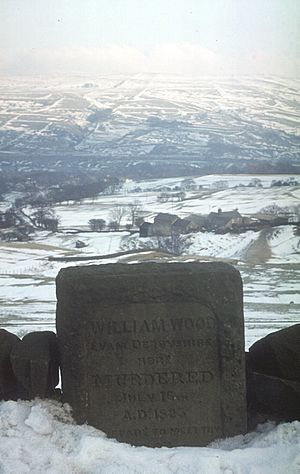Murder stone facts for kids
Murder stones are old stone markers found in the countryside of the United Kingdom. They became very popular in the 1820s. These stones were put up where sad or shocking events had happened. They usually remember the person who died or warn people about the results of doing bad things. Some stones also remind people to be careful. Many of these stones are now important local landmarks. Some are even protected as listed structures, which means they are special historic buildings.
What Are Murder Stones?
Murder stones are stone monuments with words carved into them. They are placed at or near the spot where a very sad event took place. These events often caused a lot of shock in the local community. Most of the stones we know today were put up over about a hundred years, with many appearing in the 1820s.
There is one stone, a rough boulder with just the word "murder" carved on it, near Ardwell in Scotland. People traditionally say it dates back to 1551. It is linked to the story of a local leader, the Laird of Castle Clanyard, who was killed by someone from Clan McCulloch. However, experts think this stone was also likely made in the 1800s.
All the known murder stones are in the countryside, not in cities. You can find quite a few in England. Only a few are known in Wales, like one near Cadoxton. The Ardwell stone is the only one recorded in Scotland.
Why Were They Put Up?
Most murder stones mark places where the person who caused the harm was found and faced justice. But some stones mark events where the person was never caught. Important local people, like religious leaders, landowners, or local officials called justices of the peace, often paid for these stones to be made.
The purpose of the stones varied. Many simply remember the person who died. Others warn people who might do similar bad things about what could happen to them. This could be a warning about facing the law or about a higher power judging them.
For example, the stone at Cadoxton is said to have been placed facing the house of the main suspect, who was not brought to justice. It warns: "Although the savage murderer escaped for a season the detection of man yet God hath set his mark upon him either for time or eternity, and the cry of blood will assuredly pursue him to certain and terrible righteous judgement." This means that even if someone isn't caught by people, they will still face consequences.
Another stone at Akebar in North Yorkshire simply has the date of the event and the words "do no murder." One stone from 1817 even suggests that the person who died was partly to blame for going to a fun place "without proper protection." This reminds people to be careful about their safety.
Lasting Importance
Many murder stones are now important local landmarks. Some have been given special protection as listed structures. This means they are recognized for their historical importance.
One of the most famous stones is for the Unknown Sailor. This was an unidentified man who died near Hindhead in Surrey in 1786. The famous writer Charles Dickens mentioned this stone in his book The Life and Adventures of Nicholas Nickleby, written in 1838–39. In the story, the main character, Nicholas Nickleby, sees the stone at the Devil's Punch Bowl during his trip to London.


